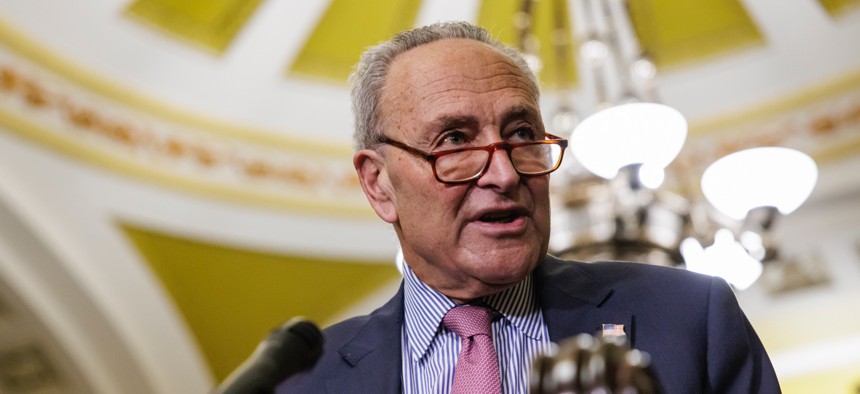Senate starts process to pass more stopgap funding measures to avoid a government shutdown

Senate Majority Leader Chuck Schumer, D-N.Y., initiated the process of crafting another continuing resolution to fund the government on Tuesday, this time through early March. Samuel Corum / Getty Images
Facing a potential shutdown at the end of the week, Congress aims to push the deadlines into early March.
The Senate on Tuesday is set to take a first procedural vote on a stopgap measure that will set up two March deadlines to fund the government, looking to once again avert a shutdown by punting on the appropriations process.
The third continuing resolution of fiscal 2024 would again take a two-tiered approach, dividing the expiration of funding into two buckets of agencies. It would also come with more promise that it will end in a full-year funding agreement, as Senate Majority Leader Chuck Schumer, D-N.Y., and House Speaker Mike Johnson, R-La., have agreed on the overall spending levels for the fiscal year. Both lawmakers, however, acknowledged appropriations would not be able to write bills to detail that spending before the first deadline set to hit this Friday and agreed to pursue another stopgap measure.
The departments of Transportation, Housing and Urban Development, Energy, Veterans Affairs and Agriculture would, under the new CR, face a March 1 deadline. The remaining agencies, which are currently set to shutter Feb. 2, would be funded through March 8.
“Unfortunately, it has become crystal clear that it will take more than a week to finish the appropriations process,” Schumer said before he teed up Tuesday’s vote, noting last week the temporary funding measure would take several days to wind through Congress and get to President Biden’s desk.
Johnson last week met with members of his caucus who opposed the spending deal he negotiated with Schumer and teased potentially backing out of the agreement. He also previously vowed not to pass any more short-term measures this fiscal year. He ultimately said he would stand by the deal and supported the CR to give Republicans time to pass individual spending bills and score “meaningful policy wins.” Schumer stressed it would require bipartisan cooperation to pass the CR on an expedited timeline that avoids a shutdown.
He cautioned some conservative members of the House have advocated for a shutdown and said it would create more leverage to reduce spending and achieve their desired outcomes on immigration reform. The House Freedom Caucus has already said Johnson’s decision to agree to a CR represented “total surrender.”
“When the hard right says they want a shutdown, they are saying they want these things: VA closures, no food inspections, delayed military benefits and so much more,” Schumer said.
Sen. Patty Murray, D-Wash., who chairs the Senate Appropriations Committee, said the CR would allow her to continue negotiating over full-year spending bills while avoiding a costly shutdown on Friday.
“Hammering out serious bipartisan funding bills is no easy task but I am going to continue working nonstop with my colleagues to pass the strongest possible bills—and soon,” Murray said. “No one back home wants to see a shutdown or chaos, so let’s quickly pass this CR and work to finalize serious appropriations bills, free of partisan poison pills, that protect key investments in our country’s future.”
With Johnson vowing to continue fighting for policy riders for which Republicans have fought, however, Congress’ ability to pass the bills is still not guaranteed. The first step in the process will involve Murray meeting with her counterpart in the House, Rep. Kay Granger, R-Texas, to determine the amount of money they will allocate to each of the 12 annual funding bills. Only once those levels are set can appropriators finalize the spending measures, including which policy changes, if any, are included. Murray and Granger last week began those discussions, which are still ongoing.
The bills will draw from the $1.66 trillion Schumer and Johnson agreed to as the top-line spending level. Defense spending will jump 3% to $886 billion and non-defense spending will stay essentially flat relative to fiscal 2023 at nearly $773 billion. If Congress can pass appropriations bills by the March deadlines, the fiscal year will be nearly halfway over and agencies will face an expedited timeline to get the money out the door.
If lawmakers were forced to pass another CR that went into May, a provision of the 2023 debt ceiling law would force devastating, across-the-board cuts that would likely require employee furloughs and significant disruptions to agency operations.
Rep. Rosa DeLauro, D-Conn., the top Democrat on the House appropriations panel, lamented that Congress wasted time during the first two CRs of fiscal 2024 relitigating the overall spending levels for the fiscal year. That delay led to the need for a third stopgap bill, but she said negotiations are now progressing with more promise.
“I am encouraged by the bipartisan conversations that have taken place since the Schumer-Johnson agreement was reached,” DeLauro said. “There is a mutual understanding that the only way to finally end the saga of 2024 funding is to write government funding bills that can earn the support of both Democrats and Republicans in the House and in the Senate.”



